12Pc Fits 2007 2008-2013 Chevrolet Silverado 1500 Wheel Bearings +Steering Parts
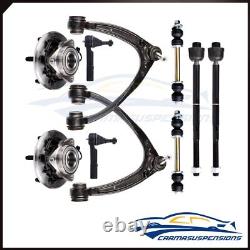
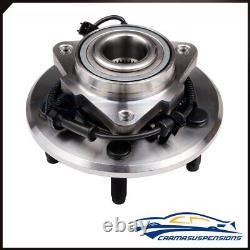
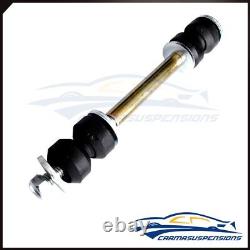
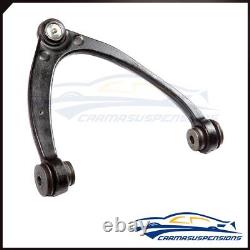
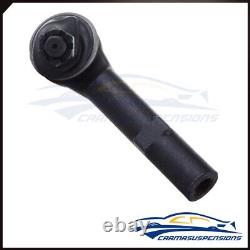
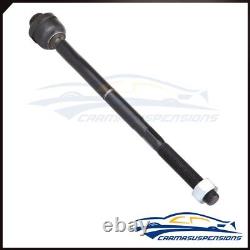

MakeModelYear RangeSpecific DetailsCadillacESCALADE2007 - 20144WD Models With 6-LugsCadillacESCALDE ESV2007 - 20144WD Models With 6-LugsCadillacESCALADE EXT2007 - 20134WD Models With 6-LugsChevroletAVALANCHE2007 - 20134WD Models With 6-LugsChevroletSILVERADO 15002007 - 20134WD Models With 6-LugsExcludes Classic ModelsChevroletSUBURBAN 1500 2007 - 20144WD Models With 6-LugsChevroletTAHOE2007 - 20144WD Models With 6-LugsGMCSIERRA2007 - 20134WD Models With 6-LugsGMCSIERRA 15002007 - 20134WD Models 6-LugsExcludes Classic ModelsGMCYUKON2007 - 20144WD Models With 6-LugsGMCYUKON XL 15002007 - 20134WD Models With 6-Lugs. 2x Part# Front Driver & Passenger Side Wheel Hub & Bearing Assembly - 515113 1x Part# Front Passenger Side Upper Control Arm WithBall Joint - K80670. 1x Part# Front Driver Side Upper Control Arm WithBall Joint - K80669. 2x Part# Front Sway Bars (Stabilizer Link) - K700432.
2x Part# Front Inner Tie Rods Ends - EV800084. 2x Part# Front Outer Tie Rods Ends - ES800223.
2x Part# Front Lower Ball Joints - K6541. Please refer to Moog official website before narrowing down your search so as to avoid unnecessary item not as described return requests. Please contact our customer services for targeted discount after all the items are received if you have reached any targeted discount thresholds, the terms of which is at the bottom of this page. If there is a knocking or clunking noise in the area of the front axle when the car is traveling over road bumps, potholes or curbs, then there is usually a defect in a component of the wheel suspension. The side of the front axle from which the (vibration) noise is emanating can already be determined during a test drive.
The type of noise also already provides certain indications for maintenance regarding which components might be faulty. Raise the vehicle and remove the front wheels. To loosen the fastening screws and fixing nuts of the compression ball joint more easily, spray them with rust remover and allow to act for a few minutes. Loosen the fastening screws of the broken ball joint on the control arm and remove the nuts. Loosen and remove the fixing nut of the ball joint on the steering knuckle. Tip:If the ball stud rotates, hold the ball stud in place with a hexagon socket. Remove the bad or worn ball joint from the control arm. Loosen the compression ball joint on the steering knuckle using a suitable special tool. Tip:For better sealing and durability of the ball joint sleeve, a little silicone grease can be applied to the contact surface. Insert new compression ball joint in the control arm and steering knuckle and tighten with new fixing nuts.Measure the chassis and adjust it using the various holes on the compression ball joint if necessary. Finally, carry out a test drive. Sway Bar Stabilizer Link Replacement Guideline. While driving, the following signs may indicate a faulty sway bar stabilizer link: (1).
Rattling and thumping noises on rough roads. Stronger inclination of the vehicle during cornering. If the sway bar stabilizer link is found to be defective, it should be replaced as described below. Raise vehicle and remove front wheels. Tip:Always check both stabilizer links and replace them in pairs if necessary.
Spray fastening nuts of the stabilizer link with rust remover and let act for a few minutes. Loosen the lower fastening nut of the stabilizer link at the stabilizer and remove. Tip:If the ball stud also starts to turn, hold it with a suitable tool. Press stabilizer link out of torsion bar.
Loosen the upper fastening nut of the stabilizer link at the suspension strut and remove it. Press stabilizer link at suspension strut out of bracket. Insert new stabilizer link at suspension strut. Tip:Secure the ball stud against twisting with a suitable tool. Insert new stabilizer link at stabilizer.
Tip:Even if replacing the stabilizer link does not directly affect the chassis setting, we recommend checking the axle setting and adjusting if necessary after working on the suspension. Conclude with a test drive. If you feel a bump in the steering when driving over road bumps or curbs, this might be due to worn tie rod ends or inner tie rods.
Clicking noises during sudden steering movements can also be symptoms of a defective tie rod. In order to determine the exact cause and replace the defective tie rod, the car must be elevated with a vehicle lift in order to be examined more closely.
Picture(A) Note: Cleanliness is extremely important when working on the power steering. Incorrect work and contamination can lead to leakage and, in the worst case, to failure of the steering assistance. Lift the vehicle and dismount the front axle wheels. Spray the fastening nut of the tie rod end with rust remover and leave it on for a few minutes. Dismount the front underride guard. Loosen the fastening nut from the tie rod and remove it completely. Remove the tie rod end from the steering knuckle using an appropriate ball joint separator. Remove the clamp of the bellow on the steering gear.Push the bellow towards the tie rod end. Unscrew the inner tie rod from the rack. Clean the sealing face of the bellow at the steering gear.
Clean the lug of the rubber contact surface of the ball joint in the steering knuckle. Note:Always use new self-locking nuts and bolts for a reliable repair.
Mount the bellow and close the clamps with the appropriate special tool. Note:Incorrect mounting of the bellow can lead to corrosion of the rack: the steering gear starts leaking which can lead to a failure in the steering assistance.Secure the ball joint in the steering knuckle and mount the nut. Note:During mounting, the ball stud should not turn within the ball joint. This can cause damage inside the ball joint and can lead to early failure. Mount the front underride guard.
Align the wheels and adjust them if necessary. Do I need to replace the control arm if the bushings are worn? Because the weight of the car is transferred through the control arm two rubber bushings are fitted at the pivot point and bolted to the frame. Road conditions and driving habits can contribute to the wear of these bushings which will become worn and fall apart. These bushing can be inspected by raising the car up and looking for an irregular configuration of the rubber center of the bushing. Many control arms have the ball joint manufactured into the arm which will be replaced along with the control arm itself. When one control arm is worn it is highly advised to replace the opposing arm. What happens if a ball joint breaks? When a ball joint breaks, you will hear a mysterious noise inside your car wheel.Your car tire will wear-out since your alignment will be broken, and you will feel the car getting out of control. If the ball joint breaks completely, it can be separated, and things can turn sour quickly. The wheel will stop being nice and can even steer you off the road.
Broken ball joints will seriously affect the steering and suspension. It can even result in your wheel falling off the car. What happens if I don't replace ball joints? If you don't want to replace your ball joints, then get ready to experience some serious issues. The old ball joints cause mysterious clunking noise or drifting steering. Once they are worn-out, it will seriously affect your steering and suspension.However, you do not need to change the ball joints if it is new. Do I need to grease new ball joints? I would say it will be a wise decision if you grease your new ball joints. At least I will always grease a new one after the installation.
Greasing a new ball joint will make it stronger and extend its lifetime because there is a minimal amount of grease inside. I suggest you do so after the first installation.Why should I get my tie rods inspected on a regular basis? If you don't get your tie rods inspected on a regular basis, there are some warning signs to watch (and listen) for. If your vehicle pulls to one side while driving, or when braking, it's possible that bad tie rods may be the culprit. Your vehicle's tires will also show uneven wear on the inside and outside edge of the tire when there's a tire rod issue. However, one of the most noticeable signs of tie rods going bad will be a knocking sound coming from the front end of the vehicle when you turn into a parking space, or some other low speed, tight turning situation.
Vibrations One of the first symptoms that your tie rods are damaged or breaking is that the steering wheel will vibrate slightly. Control Arm & Ball Joint Assembly. K80670 K80669 K700432 EV800084 ES800223 K6541 515113.
Suspension Control Arms and Ball Joints Kit Assembly. Front Driver and Passenger Side Replacements. If you have reached any targeted discount threshold(s), please contact our customer services after you received all your items.
CARMASUSPENSIONS has the final power of interpretation of all the above Targeted Discount Terms and Procedures. Proposition 65 requires businesses to provide warnings to Californians about significant exposures to chemicals that cause cancer, birth defects or other reproductive harm. Virgin Islands, Northern Marianas, Guam are not deliverable. Which only includes suspension kit, control arm, tie rod end, ball joint, sway bar, stabilizer link, pitman arm, idler arm, steering center link.Promises free replacement due to quality defects or item not as described issues within 90 calendar days from the date when buyers receive their items in the situation when buyers are willing to provide convictive proofs or professional diagnose report if required, otherwise. Has the right to refuse any replacement requests. For Ford Ranger & Explorer 4WD 10Pcs Front Control Arms Ball Joints Tie Rods Kit. For Chevrolet Malibu Pontiac G6 Saturn Aura 8 x Control Arm Sway Bar Tie Rod Kit.
Fits Ford F-250 F-350 Super Duty - 4WD 4x4 New 5x Complete Front Suspension Kit. For Chevy GMC C1500 C2500 Suburban Tahoe 15Pcs Front Control Arms Sway Bars Kit.
For Mazda Tribute Ford Escape Mercury Front Struts Rear Shocks Sway Bar Link Set.

